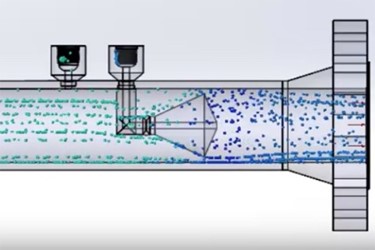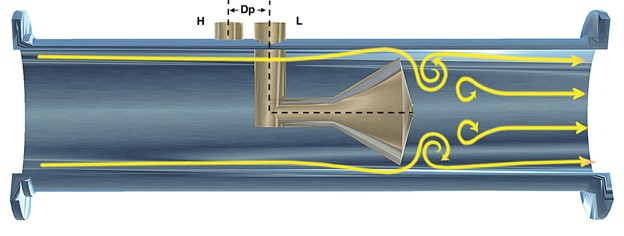- PRODUCTS
- INDUSTRIES
- RESOURCES
- SUPPORT
Retrofitting Water Systems With The Best Meters For The Job
 Although not every water, wastewater, or industrial design engineer or operations manager is familiar with the advantages of the V-Cone differential pressure (DP) meter design, they are certainly familiar with the problems it can solve. Here is a step-by-step description of how V-Cone meters with + 0.5 percent accuracy offer better alternatives in applications currently being failed by other metering technologies.
Although not every water, wastewater, or industrial design engineer or operations manager is familiar with the advantages of the V-Cone differential pressure (DP) meter design, they are certainly familiar with the problems it can solve. Here is a step-by-step description of how V-Cone meters with + 0.5 percent accuracy offer better alternatives in applications currently being failed by other metering technologies.
The first step is to appreciate the value of a mechanical meter with no moving parts, one that is not impacted by pipeline turbulence, and one that is not susceptible to the disruption of electromagnetic sensors. The second step is to differentiate V-Cone DP performance from that of other DP meter technologies — such as orifice plates or vortex meters — that can cause excessive, permanent pressure drop, elevate pump operating pressures, and drive up energy costs.
V-Cone Meters: Better On Principle
V-Cone meters that have proven their value in oil, gas, and steam applications have been a well-kept secret in water treatment, wastewater applications, and industrial uses. The secret behind V-Cone meter performance advantages in the field is contained in its mechanical design (Figure 1). With no sensitive electromechanical components, the V-Cone is a workhorse design that runs and runs, accurately, under a wide range of circumstances that challenge or compromise other meter designs.

Figure 1. The V-Cone design accurately calculates flow based on the differential pressure (Dp) between the high-pressure (H) port measuring line pressure before the cone and the low-pressure (L) port measuring pressure immediately behind the cone.
A Clear Alternative To Compromised Accuracy
Every meter design has strengths and weaknesses in different applications. Where the following issues have caused problems with other meters, the V-Cone meter design offers more accurate readings and quicker payback by avoiding the same limitations.
- Tight Quarters. There are two benefits to choosing the V-Cone design over other meter types in potable water, wastewater, and industrial process water applications. One is the ability to accommodate congested piping layouts without compromising accuracy and the second is the ability to replace existing flange-mounted meters within the exact same flange-mount lay length.
- Accuracy Issues. While mag meters are also rated for + 0.5 percent accuracy at the time of installation, not all of them will be able to maintain those accuracy levels, as process conditions affect sensor performance. V-Cone meters with no moving parts and no electronic sensing make it possible to avoid inaccuracies related to the following issues:
- Every component in a piping system has an impact on flow profiles that can affect metering performance. Elbows, step-downs, valves, chemical injection ports, and other structural elements all introduce turbulence that can impact accuracy in other types of meters if a sufficient straight length of pipe does not permit the flow turbulence to settle out. A V-Cone meter can typically be installed within 0 to 2 pipe diameters upstream and 0 to 1 pipe diameters downstream.
- Electrically Dense Environments. Another factor in the application environment that can affect mag meter reading accuracy is the presence of electrical noise or interference in electrically dense environments. Whether caused by nearby pumps, variable-frequency drives (VFDs), other electronic equipment, or the presence of stray currents in the pipeline infrastructure itself, the presence of such interference can compromise the accuracy of electromagnetic sensors.
- Dirty water applications such as turbidity in raw water intakes or wastewater effluent can coat electronic sensors, leading their reading accuracy to drift without any warning to system operators. Weeks or months of inaccuracy can compromise the recorded readings before the error becomes egregious enough to notice, creating the need for frequent inspection and cleaning.
- Maintenance Downtime And Cost. In challenging application environments, V-Cone meter designs can pay for themselves in terms of cost savings for downtime and maintenance. (See case study below.)
- Header Compatibility. Many water treatment applications combine water flowing into a single header from different points in the process. This could be done to accommodate multiple pumps running at variable flow rates for energy efficiency, or simply to recombine the outlets from multiple settling tanks or filtration lines. Because varying flow rates from multiple pipes entering one header can induce turbulence into the system, a self-conditioning cone-type meter that maintains high accuracy in these types of applications can be highly desirable.
A Perfect Fit…Or Retrofit
As good a choice as V-Cone style meters can be as initial investments for new piping designs subject to the previously mentioned accuracy challenges, they have additional benefits as a great retrofit choice for existing installations. If the original installation has no meter at all, the V-Cone’s ability to fit into tight pipeline configurations with little to no straight pipe requirements can minimize the need for reconfiguration, thereby keeping material and labor costs low. If an existing meter’s performance is compromised, the ability to order flange-mounted V-Cone meters in any lay length makes it easy to swap out existing meters with minimal downtime or disruption to the existing piping infrastructure.
Extreme Case Underscores Extreme Value
In one particular industrial operation, a metal production application involving cleaning fluids and oily residues was using mag meters to measure the volume of water being used for rinsing extruded metal. The exposure to such a nasty mix was causing the submerged mag meters to require sensor cleaning and calibration checks once or twice a year. Even with the costly annual maintenance events — approximately $50,000 per event — the mag meters were failing after an average of about three years in service. After that installation was retrofitted with V-Cone meters, the new meters paid for themselves — in terms of cleaning or recalibration maintenance savings alone — in less than a year. Furthermore, the application has had no replacement problems since the switch.
Two ancillary benefits of the V-Cone in that installation were the built-in capacity to track pipeline pressure — for pump performance monitoring — and the ability to incorporate temperature measurement to assure that process water was at the appropriate temperature.

